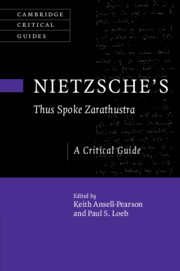Book contents
- Nietzsche’s Thus Spoke Zarathustra
- Cambridge Critical Guides
- Nietzsche’s Thus Spoke Zarathustra
- Copyright page
- Epigraph
- Contents
- Contributors
- Acknowledgments
- Note on Texts, Translations, and References
- Abbreviations
- Introduction
- Chapter 1 Laughter As Weapon
- Chapter 2 Philosophy As a Way of Life in Thus Spoke Zarathustra
- Chapter 3 What Makes the Affirmation of Life Difficult?
- Chapter 4 Zarathustra’s Response to Schopenhauer
- Chapter 5 Nietzsche’s Naturalism and Thus Spoke Zarathustra
- Chapter 6 Nietzsche’s Solution to the Philosophical Problem of Change
- Chapter 7 Zarathustra’s Moral Psychology
- Chapter 8 Zarathustra’s Great Contempt
- Chapter 9 The Great Politics of Thus Spoke Zarathustra
- Chapter 10 Joyful Transhumanism
- Chapter 11 Nietzsche on the Re-naturalization of Humanity in Thus Spoke Zarathustra
- Bibliography
- Index
- Cambridge Critical Guides
Introduction
Published online by Cambridge University Press: 09 June 2022
- Nietzsche’s Thus Spoke Zarathustra
- Cambridge Critical Guides
- Nietzsche’s Thus Spoke Zarathustra
- Copyright page
- Epigraph
- Contents
- Contributors
- Acknowledgments
- Note on Texts, Translations, and References
- Abbreviations
- Introduction
- Chapter 1 Laughter As Weapon
- Chapter 2 Philosophy As a Way of Life in Thus Spoke Zarathustra
- Chapter 3 What Makes the Affirmation of Life Difficult?
- Chapter 4 Zarathustra’s Response to Schopenhauer
- Chapter 5 Nietzsche’s Naturalism and Thus Spoke Zarathustra
- Chapter 6 Nietzsche’s Solution to the Philosophical Problem of Change
- Chapter 7 Zarathustra’s Moral Psychology
- Chapter 8 Zarathustra’s Great Contempt
- Chapter 9 The Great Politics of Thus Spoke Zarathustra
- Chapter 10 Joyful Transhumanism
- Chapter 11 Nietzsche on the Re-naturalization of Humanity in Thus Spoke Zarathustra
- Bibliography
- Index
- Cambridge Critical Guides
Summary
Friedrich Nietzsche’s Thus Spoke Zarathustra: A Book for Everyone and for No One (TSZ) (1883–1885) is a text that was celebrated by creative artists and writers in the twentieth century and it continues to have a wide readership outside academia. This book has also been appreciated by some seminal thinkers in the history of continental philosophy – notably Martin Heidegger, Eugen Fink, Karl Löwith, and Gilles Deleuze. However, recent philosophical scholarship tends to marginalize TSZ and to downplay its significance in our engagement with Nietzsche’s thought. This neglect is no doubt understandable. The text is perhaps the best example we have of his self-confessed philosophical heterodoxy, and he himself pointed out its unusual relation to the rest of his corpus: “Suppose I had published my Zarathustra under another name, for example, that of Richard Wagner—the acuteness of two thousand years would not have been sufficient for anyone to guess that the author of Human, All-Too-Human is the visionary of Zarathustra” (EH “Clever” 4; EH 1989).
- Type
- Chapter
- Information
- Nietzsche's ‘Thus Spoke Zarathustra'A Critical Guide, pp. 1 - 14Publisher: Cambridge University PressPrint publication year: 2022



